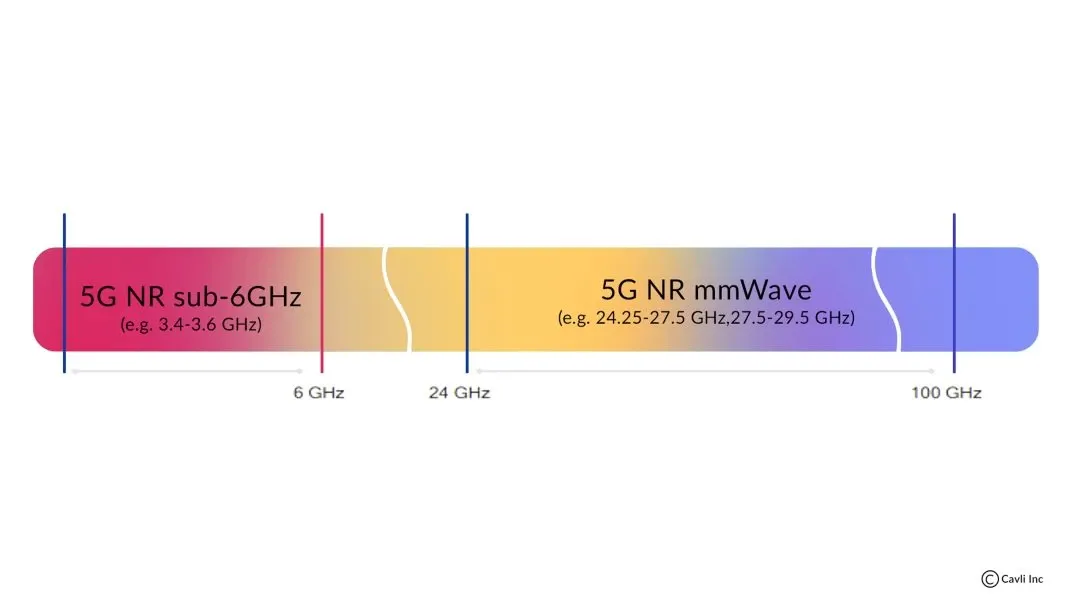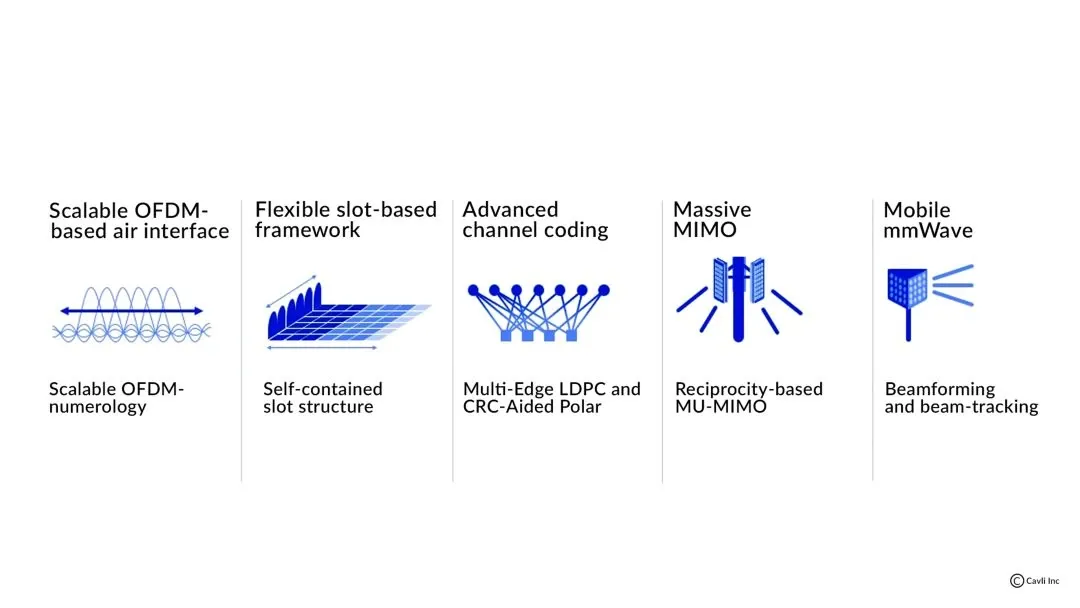Introduction
The telecommunications landscape has undergone a transformative change with the advent of the 5th-generation mobile network, 5G. This progression, building on the foundations of 4G, 3G, and 2G networks, ushers in a new era of connectivity. Central to this evolution is 5G NR (New Radio), the next-generation wireless access technology first outlined in 3GPP Release 15 and continually refined in later releases. 5G NR significantly enhances our capability to interconnect everything from simple IoT devices to complex industrial IoT systems, creating a smarter, more connected environment.
Moreover, the capabilities of 5G have been further augmented by the introduction of 5G NR-Light, also known as 5G Reduced Capability or 5G RedCap. This iteration streamlines the technology for more specific applications, improving efficiency without compromising performance.
As we explore the extensive role of 5G NR in revolutionizing connectivity, it becomes evident that 5G New Radio is not merely an upgrade but a substantial leap forward in the telecommunications domain. The full form of 5G NR stands as a testament to its pivotal role in shaping the future of global communications.
What is 5G NR?
5G NR, or 5G New Radio, is the next-generation standard for wireless communications set for mobile telecommunication. The "NR" in 5G NR stands for 5G New Radio, highlighting the new air interface used for transmitting and receiving 5G signals. This technology offers lower latency, higher system capacity, and massive device connectivity, all while consuming less energy.

5G NR is designed to support a wide range of frequency bands, including sub-6 GHz and millimeter-wave frequencies, enhancing spectrum efficiency and flexibility. The 5G NR full form, "5G New Radio," is integral to the 5G ecosystem, enabling advanced applications like ultra-reliable low-latency communications (URLLC) and massive machine-type communications (mMTC), essential for IoT and smart city developments.
Frequency Ranges of 5G NR

5G NR (New Radio) leverages specific electromagnetic frequencies to revolutionize wireless communication. This next-generation standard is divided into three key bandwidth sections:
Low Band (below 1 GHz)
- Coverage Essentials: Essential for broad coverage, the low band is crucial for 5G NR deployments in rural and suburban areas where wide-area coverage is necessary.
Mid Band (1-6 GHz)
- Balanced Performance: This range strikes a balance between coverage and capacity, making it ideal for 5G NR applications in urban settings where both reach and data speed are important.
High Band (above 24 GHz), also known as the mmWave Band
- High-Speed Connectivity: Characterized by its ability to deliver ultra-high speeds, this band is pivotal for 5G NR to achieve the highest possible data transmission rates in densely populated urban areas.
These bandwidths are categorized into two main frequency ranges in the 5G NR framework:
Frequency Range 1 (5G FR1)
- Sub-6 GHz Spectrum: This includes sub-6 GHz frequency bands, which are fundamental to 5G NR. They extend the reach and improve compatibility with a wide array of devices while ensuring efficient use of spectrum.
Frequency Range 2 (5G FR2)
- mmWave Spectrum: It spans the mmWave spectrum from 24 to 52 GHz, crucial for 5G NR to maximize throughput and minimize latency in high-demand scenarios.
By embracing these comprehensive frequency ranges, 5G New Radio significantly mitigates previous network limitations. The expansion into new frequency bands allows 5G NR to drastically reduce network congestion and enhance overall data throughput, solidifying its role as a transformative force in telecommunications.
Working of 5G NR

Technologies used in 5G NR
5G NR (New Radio) employs a suite of advanced technologies to enhance the efficiency and capabilities of the network. These include Orthogonal Frequency-Division Multiplexing (OFDM), Beamforming, Massive MIMO, Small Cells, and Dynamic TDD, each playing a crucial role in optimizing the performance of 5G NR networks.
OFDM (Orthogonal Frequency-Division Multiplexing)
OFDM is a method used in 5G NR that extends the basic frequency-division multiplexing (FDM) principle. It involves the use of cyclic prefix OFDM and DFT-Spread OFDM to distribute the overall data stream across multiple subchannels. This separation reduces interference, as the subcarrier frequencies are broadly spaced at 15kHz, 30kHz, 60kHz, and 120kHz intervals, enhancing the signal clarity and network efficiency.
Beamforming
Beamforming in 5G NR is more than just a signal processing technique; it's a strategic deployment that directs radio waves to a specific target location rather than dispersing them broadly. This focus not only strengthens the signal at the receiver but also improves data speed and energy efficiency. In 5G NR, optimizing antenna beam patterns is crucial for reducing interference and boosting the network's reliability and performance. This deep dive into beamforming reveals its pivotal role in achieving precise and efficient transmission, crucial for supporting dense urban deployments and high-demand applications.
Massive MIMO
Massive MIMO (Multiple-Input Multiple-Output) technology significantly enhances 5G NR by increasing spectral efficiency. It involves scaling the number of antennas at base stations, known as gNB antennas, which drastically expands network coverage, capacity, and throughput. Unlike previous generations, Massive MIMO in 5G NR uses these multi-antenna arrays to serve multiple users simultaneously within the same frequency spectrum, thereby multiplying the capacity of the network without additional spectrum.
Small Cells
Small Cells are integral to 5G NR for bolstering network capacity, particularly in areas with high user density. These low-power base stations utilize mmWave frequencies and are often enhanced with beamforming techniques to intensify signal strength and reach. Small cells complement macro networks by filling in coverage gaps and boosting in-building penetration, making them essential for a seamless 5G NR experience across varied environments.
Dynamic TDD
Dynamic Time Division Duplexing (TDD) is critical in 5G NR for its flexibility in managing uplink and downlink communications. By using the same frequency for both directions but allocating separate time slots for uplink and downlink, 5G NR reduces latency and adapts dynamically to varying traffic demands, which is vital for real-time applications.
Explore the Benefits of Massive MIMO in 5G Technology
Learn How Small Cell Technology Enhances 5G Networks
5G NR Applications

Applications of 5G NR
5G NR (New Radio) has revolutionized various sectors by enabling robust, high-speed, and reliable communication solutions that are reshaping how industries operate. Here’s a comprehensive look at the diverse applications of 5G NR across different industries:
Enhanced Mobile Broadband (eMBB)
5G NR dramatically improves mobile broadband experiences, supporting high-demand applications such as high-definition video streaming, immersive gaming, and live broadcasts. This enhancement is particularly transformative in the media and entertainment sector, where users enjoy seamless streaming with minimal buffering and unprecedented download speeds, significantly enriching the user experience.
Ultra-reliable and Low-latency Communications (URLLC)
In critical scenarios that demand high reliability and ultra-low latency, 5G NR excels. Industries such as automotive, healthcare, and manufacturing leverage 5G NR for essential applications including the command and control functions of V2X (Vehicle-to-Everything) in autonomous vehicles, and remote control operations in surgeries and factory settings. This facet of 5G New Radio enables real-time data transmission, essential for tasks that require immediate feedback and precision.
Massive Machine-type Communications (mMTC)
5G NR is pivotal in enabling mMTC, connecting millions of IoT devices across various scales and industries. From smart city applications that manage everything from traffic systems to energy grids, to agricultural systems that monitor soil and crop conditions, 5G NR facilitates massive connectivity with minimal energy use, enhancing the efficiency and sustainability of large-scale IoT deployments.
Specific Industry Applications
Automotive:
5G NR supports safer and more efficient operations with V2X communications, allowing vehicles to interact with each other and with road infrastructure. This integration significantly enhances the safety features of autonomous driving and improves overall traffic management.
Media and Entertainment:
In this sector, 5G NR changes the game by enabling ultra-fast streaming of high-definition content and interactive gaming with almost zero latency. These capabilities are transforming how content is created, distributed, and consumed, offering audiences quality experiences irrespective of their geographical locations.
Smart Cities:
5G NR supports smart city initiatives by enhancing the connectivity that underpins critical urban infrastructure management and public services. Whether it’s improving public safety through enhanced surveillance systems or optimizing utility management like water and electricity, 5G New Radio provides the backbone for a more connected and efficient urban environment.
Enhance your IoT solutions with our cutting-edge 5G RedCap module. Explore the specifications!
Closing Notes
5G New Radio represents a significant leap forward in wireless technology, offering unprecedented speed, reliability, and efficiency. As we continue to explore and expand the capabilities of this wireless technology through the latest 3GPP 5G NR Releases, the innovation potential is boundless. It also acts as the foundation of the 5G reduced capability - taking wireless communication to an advanced level. 5G New Radio standard is set to become the backbone of a more connected, faster, and smarter world.
To learn more, visit us at
https://www.cavliwireless.com/iot-modules/cellular-modules
Amusing Tech Chronicles
Facts and Anecdotes Related to this Edition of Wireless By Design

The Digital Ninja
With its ability to slice through network congestion and dodge interference, the 5G NR network is like a digital ninja, delivering your data with precision and agility.

The Invisible Juggler
5G NR network juggles frequencies like an invisible circus performer, handling a range of bands from low (great for coverage) to high (amazing for speed), all without dropping a single data ball

The Ant Army
5G NR antennas operate like a colony of ants. Each antenna carries data to and fro, coordinating flawlessly to build a seamless network of communication at extraordinary speeds.
Go Beyond and Explore
Is 5G NR faster than 4G LTE?
What are the different 5G NR deployment modes?
Standalone Mode: This mode relies solely on a 5G packet core for both transferring
information and signaling.
Non-Standalone Mode (NSA): It is an attractive option for areas already equipped
with 4G. NSA mode utilizes the existing 4G network control plane speeding up
implementation and cutting down on hardware costs.
Dynamic Spectrum Sharing (DSS): DSS allows for the sharing of spectrum
between 4G LTE and 5G NR based on real-time demand. Like NSA, DSS enables
quicker rollouts and reduced hardware expenses.
How does 5G NR impact IoT?
5G can support up to 10,000 devices per cell with
-
3x spectrum efficiency
-
10x experience throughput
-
100x traffic capacity
-
100x network efficiency
5G NR is designed to enable a massive scale of IoT deployments. Its high capacity, speed, and low latency facilitate more complex and reliable IoT applications, making it possible to connect and manage large numbers of devices efficiently required for massive IoT and IIoT.

